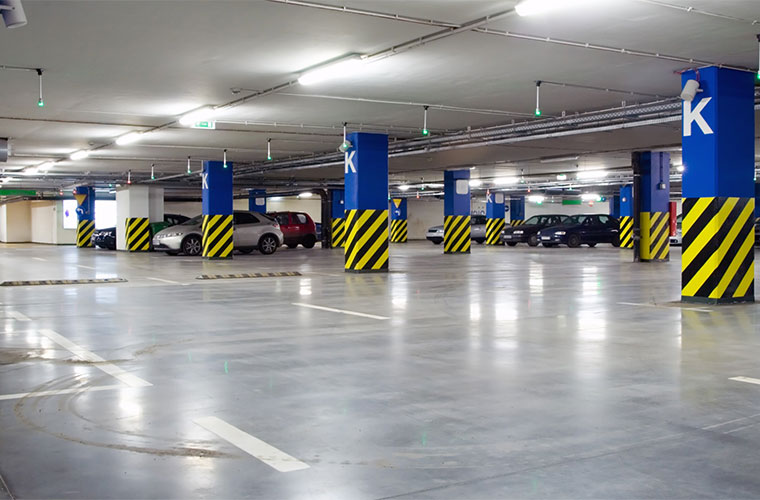A new Department of Energy report shows large increases in the use of LED lighting for area/roadway projects along with parking garage luminaires. The report, released on September 20, 2017, shows marked improvement in energy savings and light quality in just the last year alone.
You can download the entire report here.
In part, the report says:
Outdoor area lighting is a major contributor to nationwide energy use, and the market segment has been an important player in the transition to solid-state lighting. In terms of energy efficiency, LED outdoor area luminaires now easily outclass their conventional counterparts, such as xtures using high-pressure sodium (HPS) lamps. Some LED products offer the same amount of lumen output for one-third of the power consumed by an HPS-based luminaire. The efficiency difference may be even greater if delivered illuminance is considered. At the same time, these LED outdoor area lighting products can provide superior color rendition, which can improve visibility. As the energy efficiency of LED outdoor area lighting has improved, there has also been a shift toward products with a warmer color temperature, which is perhaps a response to concerns about potential glare, light pollution, and health effects of nighttime lighting.
This report focuses on outdoor area/roadway luminaires (including street lighting and wall packs), parking garage luminaires, and canopy luminaires (e.g., those used for gas station fuel pump areas). The area/roadway luminaires segment makes up a vast majority of the products considered. Although the aforementioned products are grouped together in this report under the term outdoor area lighting, the included products may be used in applications that are not strictly outdoors (e.g., parking garages). In this report, retrofit kits and dedicated luminaires in these categories are not considered separately, as only in the area/roadway category did retrofit kits make up a notable percentage (8%) of the total products.
LED outdoor area lighting has been a major component of the LED Lighting Facts® database since its inception, consistently being one of the categories with the most products. As of September 20, 2017, area/roadway products alone comprised 21% of the database, with the other two product categories featured in this report collectively comprising approximately 5%. These percentages have been fairly consistent over the past seven years.
Since the last CALiPER Snapshot Report that focused on outdoor area lighting (September 2016), the average luminous efficacy for products listed in these categories has increased by about 9 lm/W. This has occurred as average correlated color temperature (CCT) has decreased.
The three types of products discussed in detail in this Snapshot report are the core products used to light surfaces or large areas outdoors (or in parking garages), and are categories where LED technology has made signi cant inroads. According to DOE’s 2017 LED Adoption Report,1 LED area/roadway lighting has achieved 28.3% market penetration, with parking garage xtures achieving 32.5% market penetration. In general, LED outdoor area lighting has the second- highest penetration rate of all types of products, behind only small directional xtures. Penetration rates for outdoor area lighting have approximately tripled since 2014.
Roadway lighting was one of the rst major product categories to see competitive LED products, with GATEWAY evaluations dating back to 2007. While those early products are inferior to what is available today, they provided an important starting point for a product type that is now seeing widespread deployment and providing substantial energy savings.
Using the LED Lighting Facts database, it is possible to track and understand how performance has changed over time. As with the broader set of products, the efficacy of LED outdoor area products continues to improve. Mean efficacies for the three product categories are between 99 and 106 lm/W, with more than 30 products exceeding 150 lm/W. Mean efficacies have risen by 8 to 9 lm/W over the past year. This has occurred simultaneously with decreases in average CCT. While many early LED area lighting products were 5000 K or higher, there has been a measurable shift toward 4000 K products, and there is now a sizeable percentage of products available at 3000 K or lower.
Comparative changes in efficacy, output, and power indicate some differences in the state of development for the three product types. For area/roadway lighting, average output continues to increase, perhaps relecting the emergence of LEDs in applications where greater output is needed, such as high-mast lighting and sports lighting. In contrast, the average output for parking garage and canopy luminaires has remained relative steady over the past few years, indicating that LED products can already meet all demands of the application, providing more opportunity for energy savings. Accordingly, reduction in power can then be realized through gains in efficacy.
Across the board, LED luminaires offer an energy-efficient alternative to luminaires using HPS lamps, and simultaneously offer improved color rendering characteristics. Although it is not analyzed in this report, LED products often require fewer lumens to produce equivalent illuminance levels on the surface they are lighting, thanks to better luminous intensity distributions than lamp-based luminaires have. All these trends indicate a broader range of choices for specifiers, which allows improved balancing of competing needs.
Tagged with garage lighting, LED lighting, lightED, street lighting